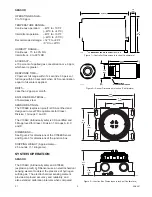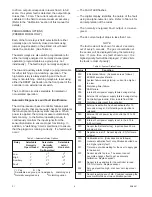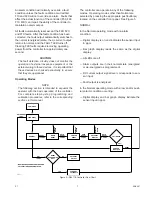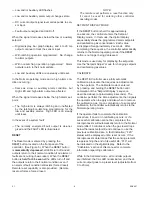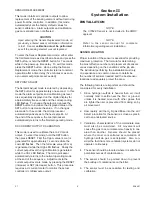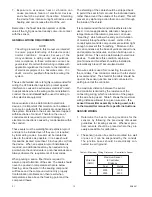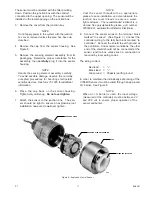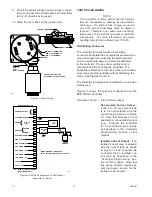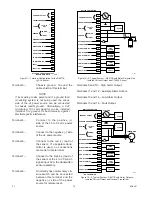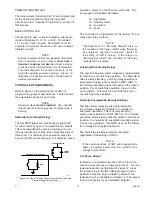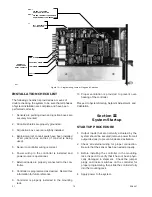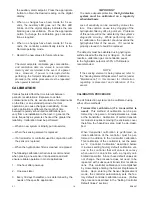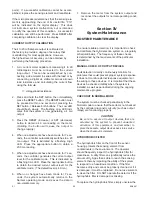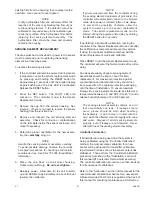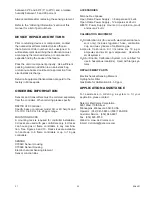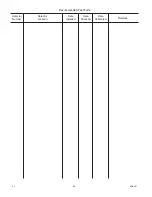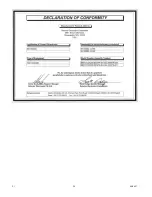
95-8401
17
2.1
NOTE
The controller has a power-up time delay to allow
the sensor output to stabilize before beginning
normal operation. During this time the outputs
are inhibited, the FAULT LED is illuminated, and
the current output indicates a fault condition.
The controller automatically exits the time delay
mode after 5 minutes have elapsed or as soon as
the sensor output no longer exceeds any alarm
setpoints.
5. Put the controller in the Setpoint Display mode
to determine the present alarm setpoints and
calibration gas concentration. If changes are
required, perform the Setpoint Adjustment proce-
dure.
6. Perform the calibration procedure.
7. Check the 4 to 20 ma current loop for proper cali-
bration and adjust as required.
8. Remove mechanical blocking devices (if used)
and restore power to the output loads.
SETPOINT ADJUSTMENT
The adjustment range in ppm for the alarm setpoints
and calibration gas concentration is as follows:
The factory settings in ppm are:
To
check
the present levels, use the “Setpoint Display
Mode” described below. To
change
the values, use
the “Setpoint Adjustment Procedure.”
SETPOINT DISPLAY MODE
1. To enter the Setpoint Display mode, press and
hold the RESET button until the Low LED begins
to blink (approximately one second). Release
the RESET button. The low alarm setpoint will be
shown for two seconds on the digital display.
NOTE
The RESET button should be released as soon
as the controller has entered the Setpoint Display
mode (after one second). If the button is still
depressed at the end of the Setpoint Display mode
(9 seconds), the controller will automatically enter
the Calibrate mode. If the operator is not prepared
to perform a calibration, a calibration fault will
occur. Recycle power to the controller to exit the
Calibrate mode without affecting the calibration
settings.
2. At the end of the two second interval, the Low
LED goes out, the High LED begins to blink, and
the digital display shows the high alarm setpoint.
3. Two seconds later the High LED goes out and
the Auxiliary LED blinks. The digital display now
shows the programmed auxiliary alarm setpoint.
4. Two seconds later the Auxiliary LED goes out
and the CAL LED blinks. The digital display now
shows the programmed calibration gas concen-
tration.
5. After displaying the calibration gas concentra-
tion for two seconds, the controller automatically
leaves the Setpoint Display mode and returns to
the Normal operating mode.
6. If adjustments to the setpoints are required, per-
form the Setpoint Adjustment procedure. When
the setpoint levels are acceptable, record this
information for future reference and perform the
Calibration
procedure.
SETPOINT ADJUSTMENT PROCEDURE
1. Determine the required alarm setpoint levels and
calibration gas concentration.
2. Press and hold the SET button for one second.
The digital display indicates the present low
alarm setpoint and the Low LED blinks. Press the
RESET button to increase the reading or the SET
button to decrease the reading. (Holding the but-
ton will cause the reading to change rapidly.)
3. When no changes to the setpoint level have been
made for 5 seconds, the Low LED goes out, the
High LED blinks, and the digital display shows the
high alarm setpoint. Press the appropriate button
(detailed in step 2 above) to obtain the desired
reading on the digital display.
4. When no changes to the setpoint level have been
made for 5 seconds, the High LED goes out, the
Auxiliary LED blinks, and the digital display shows
Range:
0 to 100
0 to 50
0 to 20
Low alarm:
5 to 40
1 to 25
0.5 to 10
High alarm:
10 to 60
2 to 45
1 to 18
Aux. alarm:
5 to 99
1 to 45
0.5 to 18
Cal. gas:
30 to 99
15 to 45
6 to 18
Range:
0 to 100
0 to 50
0 to 20
Low alarm:
10
5
2
High alarm:
20
10
4
Aux. alarm:
20
10
4
Cal. gas:
50
25
10

